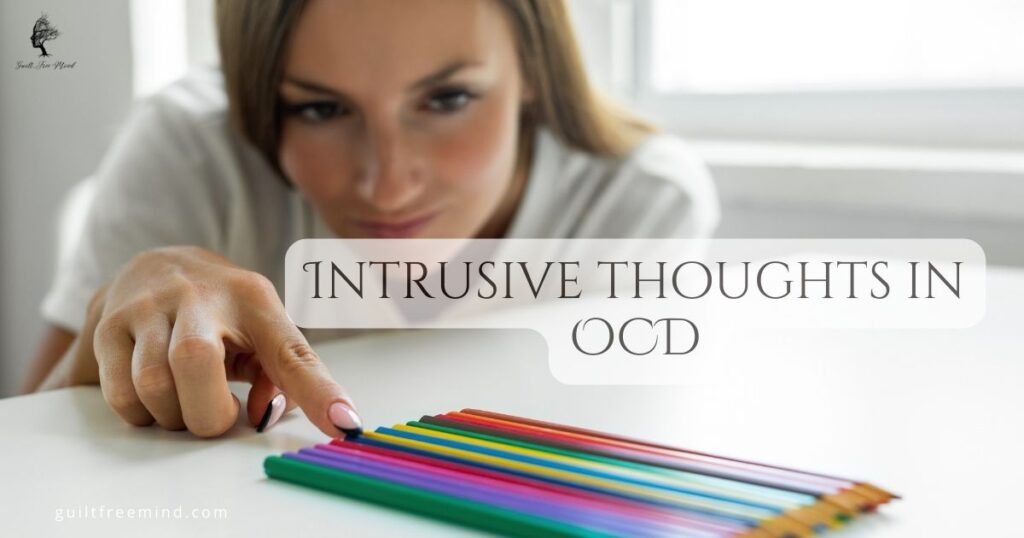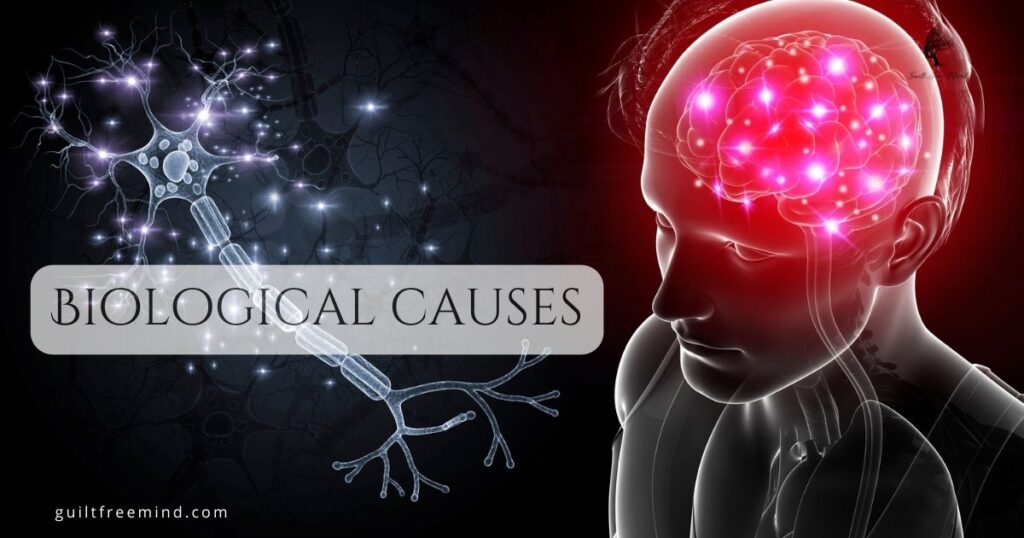Reading the heading, the first question that must have popped into your head is, “What are intrusive thoughts and intrusive thoughts in OCD?” Let’s begin this blog post by first addressing this crucial question. Intrusive thoughts can be defined as any thought that suddenly pops into your head and brings along with itself a ton of disturbance. Do you ever encounter a sudden disturbing thought that pops into your head for no apparent reason?
Suppose you are going through your day, doing your chores, and getting work done when suddenly an extremely bizarre, violent, or sexual thought pops into your head. It takes you back by surprise and you are left wondering, “What in the world just happened?”.

Table of Contents
What are intrusive thoughts in OCD?
These thoughts can range from being seemingly benign like doing something embarrassing in public to extremely disturbing like thoughts of harming someone you would never dream of hurting or engaging in sexual transgression etc. If you have encountered such thoughts from time to time, there is nothing to worry about. Such thoughts plague most of us. You are not alone in this.
In this blog post, I will discuss what are intrusive thoughts, what causes such thoughts to occur, the relationship between intrusive thoughts in OCD, when should you see a mental health practitioner for intrusive thoughts, and finally how to manage intrusive thoughts by yourself. So, if you haven’t subscribed to the blog yet, go ahead and do so. The subscription option is present in the sidebar. Your subscription will allow me to notify you the moment the next blog post releases from Guilt Free Mind. If you like watching videos, subscribe to the YouTube channel of Guilt Free Mind. Remember to ring the notification bell and set it to ALL so that YouTube notifies you the moment the next video releases from the channel.
Understanding Intrusive Thoughts in OCD
As I mentioned, intrusive thoughts may be disturbing and irrelevant to your current scenario. However, they may bring along with themselves a certain degree of disturbance and may throw you entirely off-balance. These thoughts range from being simple and funny to extremely disturbing. Most often, after the occurrence of the thought, the person is left wondering, “Why did such a thought come to me in the first place?”
What causes intrusive thoughts?
Unfortunately, so far studies have not been able to uncover why intrusive thoughts occur in the first place. However, some psychologist researchers do have theories about the occurrence of intrusive thoughts.
Some studies have suggested that frequent and recurring intrusive thoughts may be indicative of the fact that the person is facing a difficulty or is stuck in a situation hard to get out of. Although no one is sure where these thoughts come from, they tend to constantly keep returning to bother you. The more you try to not think of it, the more they keep popping into your head.
Suppose I ask you to not think of a green elephant. Now, all you will think of is a green elephant. No matter how much you try not to think of a green elephant, by now it has secured a large enough space in your head and forcing you to only think of a green elephant.

When to worry about intrusive thoughts?
When you are healthy and you are mentally stable, you can monitor your thoughts well. Under such situations, intrusive thoughts are nothing more than a dot on your radar. The moment you decide not to engage any of your resources towards the thought, the thought goes away.
However, in case you find yourself constantly handling violent, bizarre, unwanted, or disturbing thoughts, you may be a victim of a serious mental health issue. Two of the most common diagnoses that cause a constant barrage of intrusive thoughts are Obsessive Compulsive Disorder (OCD) and anxiety.
Seven most common examples of intrusive thoughts
Many types of negative thoughts can trigger an intrusive thought pattern in a person. These intrusive thoughts mostly arise from shame, guilt, and distress. Here are the seven most common examples of unwanted intrusive thoughts:
The thought of hurting your child or baby
If you have recently had a child or adopted one, there is a high probability that you have experienced intrusive thoughts regarding your child. You may have experienced sudden thoughts about accidentally or unintentionally hurting your charge.
Studies have shown that around 50% of new parents tend to experience intrusive thoughts at some point. They are constantly worried about the safety of their child. Thus, thinking that their child may be hurt by them or by accident can disturb them from time to time.
Thoughts of engaging in illegal or criminal actions
The second form of intrusive thought pattern that is very commonly observed is the thought of engaging in violent or illegal behavior. This violent behavior can either be implicated in yourself or someone else. These are not things or activities you wish to engage in. Thus, the occurrence of such thoughts disturbs you. However, the sudden appearance of such thoughts out of the blue can make you question your subconscious mind. If you are unable to brush these thoughts off, they can make it difficult for you to lead a normal and happy life.
Doubts causing thoughts
The worst and also the most common types of intensive thoughts to take up space in our heads are doubts. These doubts can range from the tiny and inconspicuous things to the big aspects of your life like your career, and relationships-. Eg: the presence of intrusive thoughts can cause you to question your sexual orientation, whether your partner is being faithful to you, or if what you feel is true love towards the other person.
Alternatively, you may also worry about little things like:
- Did you lock the door of your house?
- Did you turn the stove off?
- Did you send the message to the right person?

Sudden unexpected reminders regarding painful past
Many people tend to experience intrusive thoughts regarding their past traumas as well. Most often, such thoughts are triggered by things or people in the person’s current environment like suddenly seeing an object may trigger a memory of a painful event. It can be a smell, an object, or even a person. Sometimes, the trigger may not be obvious and the person may wonder why the thought came up at all.
Worry about serious illnesses
Living in a world post-COVID-19 has been hard on all of us. It is not uncommon for people to get intrusive thoughts regarding catching serious illness. Worrying about contamination or catching a disease due to the germs in the environment are very common intrusive thoughts that plague many people. You worry that you may fall sick even if the chances of it happening are slim to none. Such intense thoughts can give rise to other unwanted behaviors like excessive hand washing or avoiding socialization or people altogether.
Worry about engaging in an embarrassing action
A fair share of people worry about embarrassing themselves in front of others in public. You may worry about having an outburst, shouting, saying something indecent, or engaging in inappropriate actions while out in public. At times, the roots of these intrusive thoughts are rooted in memory, especially if you had an embarrassing moment in public before.
Intensive sexual thoughts
If you are embarrassed about sudden sexual thoughts occurring in your head, you are not alone in this. Even though having sudden inappropriate thoughts about sex is considered taboo in society, it is fairly common. Having sexual thoughts and acting on them are two different things. Some people have inappropriate or intrusive thoughts about having sex with children, or an office coworker. The only way to proceed is to brush these thoughts away and carry on with your life. It may be hard to communicate such thoughts. This makes it very hard to reach out for help when you need it
The relationship between intrusive thoughts and OCD
Obsessive Compulsive Disorder or OCD is a pretty complex mental health condition that is characterized by cycles of compulsions and obsessions that can cause a major disruption in the affected person’s life. One of the characteristic features of OCD is the constant loop of intrusive thoughts. This loop of negative thoughts has a central role in the obsessive-compulsive thinking pattern. Let’s figure out how the presence of intrusive thoughts makes handling a condition like OCD even harder.
The obsessive-compulsive cycle
Those who suffer from OCD, suffer from distressing emotional responses as a result of the intrusive thoughts. These distressing responses most often occur as anxiety, disgust, or guilt. When those suffering from OCD experience intrusive thoughts, they most often try to alleviate the feeling by engaging in a compulsive behavioral pattern or mental rituals. These compulsions can either manifest as physical actions like checking locks and washing hands to mental rituals like praying counting or repeating a certain phrase over and over again. Unfortunately, such compulsions only allow temporary relief from the thoughts but the physical and mental repetitions keep going on.
Bidirectional influence
The relationship between OCD and intrusive thoughts is bidirectional. This means that intrusive thoughts can be a result of OCD and be driven by OCD as well. Intrusive thoughts most often act as catalysts. They spark the cycle of compulsions and obsessions. On the other hand, the cycle of obsession-compulsion further reinforces such thoughts. The engagement in the compulsive behavior makes the sufferer feel that the engagement can reduce the stress, fear, and anxiety brought on by the intrusive thought. Therefore, a positive feedback loop is set in motion where the person keeps engaging in compulsive behaviors because they wish to escape a stressful thought.

Common intrusive thought patterns in OCD.
In the case of OCD, intrusive thoughts can spread over various topics and themes. It may not be limited to non-OCD people’s standard intrusive thought patterns. Their fears may stretch over religions, sexual taboos, perfectionism, symmetry, and a variety of other things. Such thoughts are extremely disturbing for a normal person. However, in the case of OCD, these can be even more disturbing. Such thoughts interfere with the person’s self-identity and core principles. The distressing and anxious nature of these thoughts acts as the driving force that causes these compulsive behaviors to continue for the alleviation of the stress.
The anxiety cycle
OCD and intrusive thoughts, both fuel anxiety. Anxiety is also a crucial factor that acts as a connection between OCD and intrusive thoughts. Intrusive thoughts can trigger anxiety in a normal person too. So imagine the effect on someone who also suffers from OCD. The intrusive thoughts cause anxiety and the person engages in compulsive behavior to relieve the anxiety. However, as the person engages in compulsive behaviors, the anxiety keeps increasing instead of reducing. The more the person engages in compulsive behavior, the more the anxiety increases. This further causes their brain to establish an association of the intrusive thought with a looming danger, and in turn, more and more of the thoughts keep occurring.
Triggers and causes behind intrusive thoughts in OCD
As I mentioned before, the sudden appearance of distressing ideas and thoughts can throw a normal person off balance. However, in the case of OCD patients, the thoughts are not easy to get rid of. They are extremely disruptive and distressing. Here are some of the triggers that may incite such thoughts in the case of those suffering from OCD.
Biological factors behind intrusive thoughts in OCD
Genetics
Studies have shown that genetics has a major role to play in the case of OCD and intrusive thoughts. It has been observed that if a close family member of the patient has OCD, the chances of the patient displaying similar symptoms are higher.
Brain neurochemistry
In case there are imbalances in the level of neurotransmitters like serotonin, it can contribute towards boosting the chances of occurrence of intrusive thoughts. Serotonin is a neurotransmitter that has a huge role in regulating levels of anxiety and mood.
Environmental factors
Several environmental factors can boost intrusive thoughts like living in a toxic environment and dealing with high levels of stress at the workplace or in interpersonal relationships. Let’s look at which environmental factors contribute to furthering intrusive thoughts and anxiety.
Stress
If you are leading a stressful life or are constantly under stress due to your work or relationship issues, it can increase the occurrence of intrusive thoughts. Stress acts as a trigger that further fuels intrusive thoughts and keeps them going.
Trauma
If you have previously experienced trauma and suffer from OCD, deep intrusive thoughts can arise as a result of the traumatic experience. Whether the trauma was in childhood or adult years, intrusive thoughts can start popping in sometime after the traumatic incident. If the cause is repressed childhood trauma, there is a chance that the intrusive thoughts develop later in life and the person finds it hard to figure out why these thoughts are arising in the first place.

Major life changes
Sudden and significant life changes can have a huge negative effect on a person’s psyche. Even a normal person may feel thrown off by the same. However, when a person is already suffering from OCD, such changes can cause a huge disruption in the person’s mental stability and lead to a barrage of intrusive thoughts that can be extremely hard to control.
Cognitive factors behind intrusive thoughts in OCD
Now that I have covered the environmental factors contributing to intrusive thoughts, let’s shift our attention toward cognitive and mental factors.
Cognitive distortions
Those who have pre-existing cognitive distortions like overthinking, OCD, perfectionism, or catastrophizing are much more prone to suffering from intrusive thoughts than normal people. These distorted thinking patterns can further fuel and magnify the thoughts.
Hyperawareness
Sometimes people are hyper-aware of their thoughts. They constantly think of their thoughts, wonder about their origination, wonder why they are thinking of what they are thinking, is this thinking pattern normal? etc. These thoughts create a heightened sensitivity in the person regarding disturbing and unusual mental content which further amplifies the problem.
Media exposure
Media has a huge role in shaping our thought processes. How we perceive and view the world is dependent a lot on the influence media has on us. Here is how media exposure causes intrusive thoughts.
Entertainment and news
When you are constantly exposed to violent media, stressful news, information, graphic imagery, etc., such images and news pieces can cause the production of intrusive thoughts consistent with the media portrayal. Such thoughts can also get triggered in case of unrelated situations.
Memory triggers
Situations and events can unconsciously trigger memories and scenes associated with the distressing events of the past. These memories fuel intrusive thoughts and can allow them free passage into your mind.
Fear of losing control
Those who suffer from OCD are constantly grappling with gaining control of their own lives. They are worried all the time over loss of control over their actions and thoughts. This constant fear and heightened vigilance boosts the intrusive thoughts making them more threatening.
Sleep deprivation
Sleep has a crucial role in almost all mental health issues. When you lack a proper level of sleep, you are more susceptible to anxiety, depression, and even intrusive thoughts. In the absence of adequate sleep, your intrusive thoughts frequency may get worse.
How to deal with intrusive thoughts in OCD
By now you know if you are a victim of intrusive thoughts and the possible causes behind the same. The next part of this blog post will focus on how to deal with these intrusive thoughts. A word of caution: please do not hope that the strategies will take effect in a day. Mental healing is a long-term process that requires time, patience, and effort on your part. Even if it seems that initially the strategies are not taking effect, you have to keep going for at least 3 months. Make these strategies a part of how you function and operate and watch the difference in your thinking pattern.

Focus on mindful behavior
Mindfulness means being in the moment without any judgment. Allow your thoughts to roam freely in your head. They can come and go as they please. Try to not hold on to a specific thought or allow it to make a home in your head. When the thoughts seem to overwhelm you, focus on your breathing and take your attention away from the thoughts. Count your breath and try to count more numbers as you breathe in and out. This practice will help you take your mind away from the intrusive thoughts.
Cognitive restructuring
Sit down and write your thoughts. This will help you find the faulty thoughts in your head. Focus on the disruptive thought. Challenge them. Look for evidence to support your thoughts. If you don’t find apt evidence, let the thought go. It’s probably your overthinking giving rise to that thought. Work with your therapist to replace the negative thoughts with realistic ones.
Exposure and response prevention (ERP)
ERP is a part of the cognitive behavioral therapy technique. Exposure and response prevention is considered to be a cornerstone of CBT. In this method, the person is exposed to triggers or situations that may invoke intrusive thoughts while focusing on resisting the urge to give in to the thought and engage in some form of compulsive behavior. When a person engages in such form of training regularly, over time the distress and anxiety that accompanies such thoughts reduce. The person gains a new viewpoint towards the distressing thought patterns.
Thought reframing
The next strategy on the list is reframing your thought patterns. If you are someone who tends to always see the glass as half full, your mind will always take you towards the depressing and unsettling scenarios first. The moment the negative thoughts become overwhelming, our natural tendency is to suppress them to escape. Instead of running or wallowing in guilt, tell yourself that the events do not define you. One thought does not mean you are a bad person. It’s just a thought. Having a thought does not mean that you will act on it.
Have a worrying time
If you always try to suppress your thoughts, there will come a time when the dam will break and suddenly you will be engulfed by many overwhelming thoughts. This sudden flood can make it very difficult to carry on if you are at your workplace, attending a call, or participating in a social gathering. Therefore the best way to handle intrusive thoughts is to have a specific time of day devoted to it. During that time, write down all your worrisome thoughts, analyze them, and identify the triggers. You can couple this task with the process of journaling. This will help you think and process your thoughts in a much easier manner. It will also reduce the sudden impact that these thoughts can bring if they are suppressed.
Focus on activities that make you happy
Set aside some time to engage in activities that you enjoy and that lift your mood. Such activities will help distract you from the distracting thoughts and allow you to focus on something else. You can spend time with your family, and loved ones or start learning something new.
Have a thought journal
Everyday journaling is a good option for sorting out your thoughts and logically categorizing them. Regular journaling also makes it easier to identify intrusive thoughts at the starting phases so you can put a stop to them before they overwhelm you. J journaling is also a great way to track your progress over time. Regular journaling can easily identify whether your habit of intrusive thinking is increasing or decreasing.

Focus on self-compassion
If you cannot forgive yourself for your thoughts, you cannot move ahead with life. Step one in healing is practicing self-compassion and learning to forgive yourself. Having some intrusive thoughts is a common occurrence and does not define you in any manner. Learn to be patient with yourself and your thoughts and stay away from self-criticism.
Opt for professional help
You are not alone. There is no reason why you should struggle alone. Take help when you need it. A therapist can help you understand why you may be having too many intrusive thoughts, teach you to get them under control, and keep them from becoming overwhelming for you. You can either go to a psychiatrist, psychologist, or therapist. They will help you understand, manage, and reduce the occurrence of intrusive thoughts.
Medication
Your psychiatrist may prescribe you certain medications like selective serotonin uptake inhibitors (SSRIs) to help you manage the OCD symptoms, like intrusive thoughts. Medication may either be used alone or alongside therapy.
Support System
Understanding and support are crucial to overcoming any mental health issue. OCD and intrusive thoughts are no different. The support and understanding of your family and friends can make a huge difference to your progress in this battle.
Conclusion
Everyone gets intrusive thoughts from time to time. However, this does not make them evil in any way. However, if the intrusive thoughts make it difficult for you to lead your daily life normally, you should start looking into getting help.
Understanding the right combination of strategies can take a while. So be patient and work with your therapist. Don’t stop seeking help after a few sessions. Therapy takes months to start showing the difference. Therapy and a proper support system comprised of your family and friends can help you heal faster. Be kind to yourself and practice patience. Use the above-mentioned strategies and keep working on yourself to better manage your thought process.
If you want to lead a more fulfilling and happy life, subscribe to Guilt Free Mind. The subscription option is present in the sidebar. Your subscription will allow me to notify you the moment the next blog post releases. This way, you will never miss out on any valuable information about mental health. If you like watching videos, subscribe to the YouTube channel of Guilt Free Mind. Remember to ring the notification bell and set it to ALL.
If you have any queries or suggestions about how to deal with intrusive thoughts, feel free to put them in the comment section. I will respond as soon as I can.
See you in my next blog post
Dr. Shruti
Frequently Asked Questions
Here are some common examples of intrusive thoughts :
-the thought of hurting a child.
-Violent thoughts
-Doubt- causing thoughts
-Thoughts of catching an illness
-Sudden unwanted sexual thoughts
-Embarrassing thoughts.
Most often the root causes behind intrusive thoughts are stress and anxiety. Biological factors like hormonal changes may also cause intrusive thoughts in women. Underlying factors that heighten the occurrence of intrusive thoughts are OCD, anxiety disorders, PTSD, etc.
Usually, intrusive thoughts are harmless. However, if you are constantly obsessing over them and they are causing interruptions in your daily life, you should consult a psychiatrist or a psychologist.
Here are a few strategies you can employ to battle intrusive thoughts:
mindfulness meditation
cognitive behavioral therapy
visualization technique
journaling
spending time in nature.
